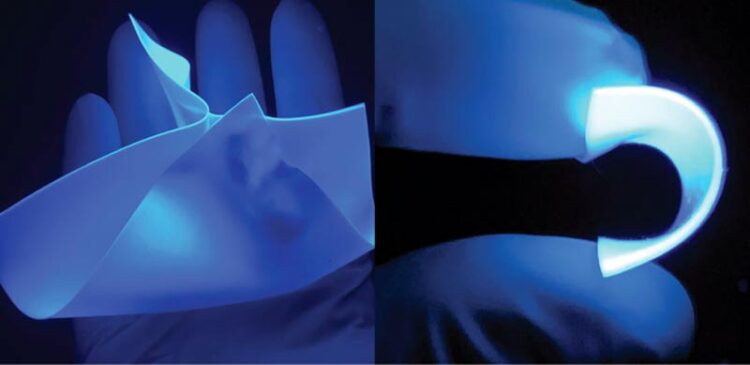Super scintillators enable X-ray detection at an ultralow level

A new scintillation material developed by KAUST scientists can bring significant improvements to X-ray imaging in medicine, industry and security.
Credit: © 2022 KAUST
The introduction of lead-free metal halide powder into a scintillation screen took some tinkering. Once a KAUST team worked out the right technique, they were able to produce an exceptionally efficient, robust and flexible scintillation film to bring significant improvements in medical, industrial and security X-ray imaging.
Scintillation materials release visible light, or “scintillate,” in response to absorbing invisible X-ray high-energy photons. They are used to construct digital images that reveal the relative passage and obstruction of X-rays as they encounter any solid object, such as a region of the body, an industrial component or an object being screened for security purposes.
X-ray scintillation is already routine technology, but researchers are continually exploring ways to make it more sensitive, efficient and readily adaptable.
“Currently used materials suffer from several drawbacks, including complex and high-cost fabrication processes, radioluminescence afterglow and nontunable scintillation,” says Yang Zhou, a postdoc in Omar Mohammed’s lab.
Materials called lead halide perovskites have attracted considerable attention and shown significant promise. Novel perovskites are a category of materials that share the same crystal structure as the natural perovskite mineral calcium titanium oxide, but they include a variety of different atoms that replace all or some of those found in natural perovskite. Lead halide perovskites incorporate both lead and one or more elements of the halogen group, such as fluorine, chlorine, bromine and iodine.
Despite the abilities of lead halide perovskites as X-ray scintillators, their commercial applications are limited by technical problems, including poor stability when exposed to light and air, reabsorption of some of the scintillated light and the toxicity of lead.
The KAUST team have overcome these problems by developing lead-free metal halides based on cesium, copper and iodide ions in the ratio Cs3Cu2I5, with crystals of that material incorporated into thin and flexible films of the polymer polydimethylsiloxane.
The researchers say it was challenging to get the copper halide powders uniformly distributed in the film, but eventually achieved this by dispersing the powder in solvent before adding polydimethylsiloxane.
Their flexible scintillation screens can detect X-rays at ultralow levels, approximately 113 times lower than a typical standard dose for X-ray medical imaging,” says Omar Mohammed, leader of the research group.
“Another vital advance is that the X-ray spatial resolution reported in this study is the highest achieved to date for powder-based screens,” says Zhou.
“The physical flexibility of our films is also very important,” adds Mohammed. He explains that highly efficient flexible scintillation screens are urgently needed for using X-rays to better analyze awkward shapes.
The team already has plans to commercialize their advance. They also hope to refine their fabrication techniques and explore the potential of similar screens made from similar material compositions.
Journal: ACS Energy Letters
DOI: 10.1021/acsenergylett.2c00075
Method of Research: Experimental study
Article Title: Large-Area Perovskite-Related Copper Halide Film for High-Resolution Flexible X-ray Imaging Scintillation Screens
Article Publication Date: 26-Jan-2022
Media Contact
Michael Cusack
King Abdullah University of Science & Technology (KAUST)
michael.cusack@kaust.edu.sa
Office: 009660128083040
Expert Contact
Omar F. Mohammed
King Abdullah University of Science and Technology (KAUST)
Omar.Abdelsaboor@KAUST.EDU.SA
Original Source
All latest news from the category: Materials Sciences
Materials management deals with the research, development, manufacturing and processing of raw and industrial materials. Key aspects here are biological and medical issues, which play an increasingly important role in this field.
innovations-report offers in-depth articles related to the development and application of materials and the structure and properties of new materials.
Newest articles

A universal framework for spatial biology
SpatialData is a freely accessible tool to unify and integrate data from different omics technologies accounting for spatial information, which can provide holistic insights into health and disease. Biological processes…

How complex biological processes arise
A $20 million grant from the U.S. National Science Foundation (NSF) will support the establishment and operation of the National Synthesis Center for Emergence in the Molecular and Cellular Sciences (NCEMS) at…

Airborne single-photon lidar system achieves high-resolution 3D imaging
Compact, low-power system opens doors for photon-efficient drone and satellite-based environmental monitoring and mapping. Researchers have developed a compact and lightweight single-photon airborne lidar system that can acquire high-resolution 3D…





















